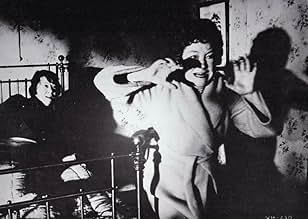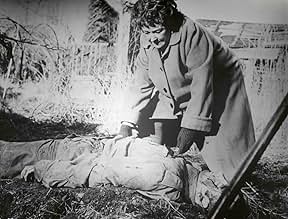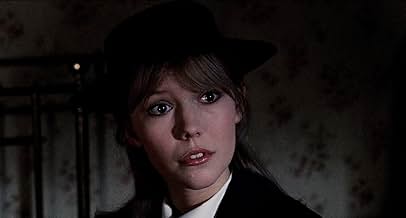NOTE IMDb
4,9/10
1,2 k
MA NOTE
Ajouter une intrigue dans votre langueSoldiers in a rural English town are being brutally murdered by an unknown creature. Two sisters living nearby realize they might understand what's happening.Soldiers in a rural English town are being brutally murdered by an unknown creature. Two sisters living nearby realize they might understand what's happening.Soldiers in a rural English town are being brutally murdered by an unknown creature. Two sisters living nearby realize they might understand what's happening.
- Réalisation
- Scénario
- Casting principal
Avis à la une
Not half as bad as some make out and if as is said it went out on a double bill with 'Blood on Satan's Claw', I reckon that was pretty good value. This doesn't have the dolly birds and swinging London paraphernalia but instead two solid performances from Flora Robson and Beryl Reid more than compensates. The kills are surprisingly bloody, the situation with the two spinsters well done and although the final explanation is a bit wordy and prolonged but at least by the end we are still interested to know just who was the occupant of the cellar. Not as jolly as a lot of Tigon product and maybe the better for it for a change. More than a little creepy, not least for the way the old ladies seem, effortlessly to change roles, causing us to rethink what we reckon is going on.
One of my sci-fi/horror/fantasy reviews written 50 years ago: Directed and written by James Kelly; Produced by Graham Harris; Associate Producer: Christopher Neame, for Tigon British, released in America by Cannon Films. Photography by Harry Waxman and Desmond Dickinson; Edited by Nicholas Napier-Bell; Music by Tony Macaulay. Starring: Flora Robson, Beryl Reid, Tessa Wyatt, John Hamill, Peter Craze, T. P. McKenna and Vernon Dobtcheff.
Fine low-budget horror thriller staged like a play, involving spinsters Beryl & Flora who keep a monstrous relative indoors. Excellent acting by the duo, plus repetitive but ultra-violent flash-cut gore montages focusing first-person on the victim.
Fine low-budget horror thriller staged like a play, involving spinsters Beryl & Flora who keep a monstrous relative indoors. Excellent acting by the duo, plus repetitive but ultra-violent flash-cut gore montages focusing first-person on the victim.
This was the first title from Anchor Bay UK's "Tigon Collection" Box Set that I checked out - being already familiar with the higher-profile titles among them, namely WITCHFINDER GENERAL (1968) and THE BLOOD ON SATAN'S CLAW (1970). While the film isn't as bad as its reputation would suggest, and is actually well worth watching, it is by no means a classic. The interesting premise classifies it as an anti-war movie but it was deemed to be too talky by executive producer Tony Tenser and, along with some cuts, he ordered the addition of sex and violence inserts to heighten its commercial potential. However, incongruous as they may seem alongside the film's generally deliberate pace, these rapidly-cut scenes of the rampaging 'beast' work quite well!
The film's mainstay, of course, are committed performances by the two elderly female leads - Beryl Reid and Flora Robson - but also T.P. McKenna as the police official investigating the murders. John Hamill and Tessa Wyatt's contribution - intended to provide the requisite romantic interest - is largely negligible, however. Perhaps the best scene in the film is Reid's lengthy account to McKenna of their family's back-story, disclosing the identity of the 'beast' and the reason for its violent behavior. One may notice inconsistencies in the lighting scheme throughout; this is the result of having two separate cameramen - with very different styles - working on the film, albeit both very well regarded exponents of the field (Harry Waxman and Desmond Dickinson). Tony Macaulay's over-emphatic score, however, works against the film's attempt at creating suspense and, ultimately, is what dates it most of all.
THE BEAST IN THE CELLAR was actually released as a double-bill with the far superior THE BLOOD ON SATAN'S CLAW, which I rewatched later in the week. Director Kelly made only one other film before his untimely death - NIGHT HAIR CHILD (1971) - which, incidentally, I should also be watching fairly soon since I recently got a copy of it! The main supplement on the Anchor Bay UK DVD is the Audio Commentary, which is pretty adequate: Tenser's memory isn't so lucid and is occasionally hard to understand, but associate producer Christopher Neame (son of director Ronald) made up for this by his highly articulate observations and recollections about this particular film.
The film's mainstay, of course, are committed performances by the two elderly female leads - Beryl Reid and Flora Robson - but also T.P. McKenna as the police official investigating the murders. John Hamill and Tessa Wyatt's contribution - intended to provide the requisite romantic interest - is largely negligible, however. Perhaps the best scene in the film is Reid's lengthy account to McKenna of their family's back-story, disclosing the identity of the 'beast' and the reason for its violent behavior. One may notice inconsistencies in the lighting scheme throughout; this is the result of having two separate cameramen - with very different styles - working on the film, albeit both very well regarded exponents of the field (Harry Waxman and Desmond Dickinson). Tony Macaulay's over-emphatic score, however, works against the film's attempt at creating suspense and, ultimately, is what dates it most of all.
THE BEAST IN THE CELLAR was actually released as a double-bill with the far superior THE BLOOD ON SATAN'S CLAW, which I rewatched later in the week. Director Kelly made only one other film before his untimely death - NIGHT HAIR CHILD (1971) - which, incidentally, I should also be watching fairly soon since I recently got a copy of it! The main supplement on the Anchor Bay UK DVD is the Audio Commentary, which is pretty adequate: Tenser's memory isn't so lucid and is occasionally hard to understand, but associate producer Christopher Neame (son of director Ronald) made up for this by his highly articulate observations and recollections about this particular film.
I remember viewing this movie when I was a kid. I recall it terrified me immensely and it stayed with me all these years. I spent a couple of years trying to find it online...didn't remember the title, only the storyline. After searching and searching, I came across a VHS that was being sold on E-Bay. I was excited and when it finally arrived, I jammed it into the VCR and couldn't help but feel a bit nostalgic. Needless to say, I was slightly disappointed. This wasn't the movie I remember watching as a kid. It was boring at times and I found Beryl Reid's incessant whinning extremely annoying. Both performances by Reid and Flora Robson were good overall but the movie wasn't scary. I think any movie is worth viewing to form you're own opinion but sometimes, well......
A tale of sibling overprotectiveness taken to horrifying extremes, the 1970 British film "The Beast in the Cellar" introduces us to a very unusual pair of elderly sisters indeed. When we first meet Joyce and Ellie Ballantyne (played, respectively, by the great English actresses Dame Flora Robson and Beryl Reid), the two are in quite a flustered tizzy, as a wild animal has started to kill off some young soldiers at the military base near their isolated country home in Lancashire. The authorities suspect that a leopard is to blame, but when the two aging biddies realize that "he has escaped from the cellar"...well, let's just say that they know better. And the less said about the titular beast, the better, I suppose, for those potential viewers who somehow may not have heard.
Anyway, "The Beast in the Cellar" is something of a mixed bag, at best, and certainly not abetted by its DVD presentation. The film's main strength is unquestionably the most impressive performances turned in by its two leads. Robson's terrific portrayal was not a surprise to this viewer; I've been a fan of hers since seeing her decades ago in the great 1940 Errol Flynn swashbuckler "The Sea Hawk," in which Flora's Queen Elizabeth practically steals the show. I had not previously encountered Beryl Reid anywhere before, however, but she was so very good here that I am now inclined to seek out more of her work; her performance in 1968's "The Killing of Sister George" is supposed to be especially good. The acting turns by these two old pros aside, however, "Beast" does not offer too much to the casual viewer. It is never especially scary, or even suspenseful, and although the beast's attacks are somewhat gory, they are shot in such a dark and frenzied manner that the viewer cannot make out much. Composer Tony Macaulay's theme song for the film is eerie and excellent, but much of his incidental music seems out of place, and even non sequitur at times. James Kelly has directed his film in a fairly pedestrian manner, with little style to speak of, and his picture drags woefully in spots. Perhaps the uncut British version of the film, at 101 minutes, would be an improvement, but the 87-minute American cut seems to be missing...something. If ever a picture deserved a loving restoration! As suggested above, the DVD offered for us Yanks is a miserable-looking affair, with a scratchy print, lousy sound and many nighttime scenes rendered almost completely black on the small screen. Seeing "Beast" back when in a theatre must have been a completely different experience; it can only have improved what is, in essence, a highly interesting albeit flawed film. For this viewer, the most interesting aspect of the picture is how our opinion of the two sisters keeps changing as the film unreels. As in 1962's "What Ever Happened to Baby Jane?," our perception of which sister is more rational and which is more batty--which is more sympathetic and which is more to be condemned--is subject to fluctuation as the secret of their history is revealed. In the film's best scene, Ellie does reveal all to a flabbergasted police superintendent, and it is a story both moving and tragic, and fully detailing this most unusual family affair. Having a loving and caring sister is one thing, but heaven forbid that you ever get one like Joyce or Ellie Ballantyne!
Anyway, "The Beast in the Cellar" is something of a mixed bag, at best, and certainly not abetted by its DVD presentation. The film's main strength is unquestionably the most impressive performances turned in by its two leads. Robson's terrific portrayal was not a surprise to this viewer; I've been a fan of hers since seeing her decades ago in the great 1940 Errol Flynn swashbuckler "The Sea Hawk," in which Flora's Queen Elizabeth practically steals the show. I had not previously encountered Beryl Reid anywhere before, however, but she was so very good here that I am now inclined to seek out more of her work; her performance in 1968's "The Killing of Sister George" is supposed to be especially good. The acting turns by these two old pros aside, however, "Beast" does not offer too much to the casual viewer. It is never especially scary, or even suspenseful, and although the beast's attacks are somewhat gory, they are shot in such a dark and frenzied manner that the viewer cannot make out much. Composer Tony Macaulay's theme song for the film is eerie and excellent, but much of his incidental music seems out of place, and even non sequitur at times. James Kelly has directed his film in a fairly pedestrian manner, with little style to speak of, and his picture drags woefully in spots. Perhaps the uncut British version of the film, at 101 minutes, would be an improvement, but the 87-minute American cut seems to be missing...something. If ever a picture deserved a loving restoration! As suggested above, the DVD offered for us Yanks is a miserable-looking affair, with a scratchy print, lousy sound and many nighttime scenes rendered almost completely black on the small screen. Seeing "Beast" back when in a theatre must have been a completely different experience; it can only have improved what is, in essence, a highly interesting albeit flawed film. For this viewer, the most interesting aspect of the picture is how our opinion of the two sisters keeps changing as the film unreels. As in 1962's "What Ever Happened to Baby Jane?," our perception of which sister is more rational and which is more batty--which is more sympathetic and which is more to be condemned--is subject to fluctuation as the secret of their history is revealed. In the film's best scene, Ellie does reveal all to a flabbergasted police superintendent, and it is a story both moving and tragic, and fully detailing this most unusual family affair. Having a loving and caring sister is one thing, but heaven forbid that you ever get one like Joyce or Ellie Ballantyne!
Le saviez-vous
- AnecdotesDame Flora Robson and Beryl Reid were annoyed at the heavy cuts made in post-production, which they thought damaged this movie.
- GaffesAlthough the flashback is set around World War One, the people at the Fun Fair are wearing '70s clothing.
- Versions alternativesThe original UK cinema version was cut by the BBFC to edit shots of a couple disrobing and blood splashes during a murder scene in a barn. The 2004 Anchor Bay DVD is uncut.
- ConnexionsFeatured in Movie Macabre: The Beast in the Cellar (1984)
- Bandes originalesShe Works in a Woman's Way
Written by Tony Macaulay & Barry Mason
Sung by Tony Burrows with The Edison Lighthouse
Meilleurs choix
Connectez-vous pour évaluer et suivre la liste de favoris afin de recevoir des recommandations personnalisées
- How long is The Beast in the Cellar?Alimenté par Alexa
Détails
- Date de sortie
- Pays d’origine
- Langue
- Aussi connu sous le nom de
- The Cellar
- Lieux de tournage
- Horsted Keynes Railway Station, Station Approach, Horsted Keynes, Haywards Heath, West Sussex, Angleterre, Royaume-Uni(train station exterior/roadway)
- Sociétés de production
- Voir plus de crédits d'entreprise sur IMDbPro
- Durée1 heure 41 minutes
- Mixage
- Rapport de forme
- 1.66 : 1(original ratio)
- 1.85 : 1
Contribuer à cette page
Suggérer une modification ou ajouter du contenu manquant

Lacune principale
By what name was Le monstre des oubliettes (1971) officially released in Canada in English?
Répondre




























